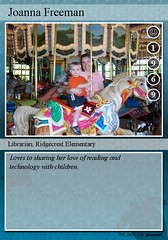I agree with a lot of the award winners on the
Web 2.0 Award winners list. It's always fun to find new favorites among the winners, too.
Some of the known entities on the list include LibraryThing (books), Eventful (events), PBWiki (hosted wiki), FeedBurner (feed management), 43 Things (lists and polls - but I would classify it under "organization"), Google Maps (mapping), Conduit (marketing - more about this one later), Ning (mashups), Twitter (mobile technology), and Pandora (music). I feel like I might be keeping up a bit when I recognize at least 25% of the 1st, 2nd, and 3rd place winners.
I admit, I do love the t-shirts on
Threadless, too. If only I could afford them all!
I am most intrigued by the social tools right now, but they can take up a large amount of time. Is it worth it spending time interacting socially online if you always do it at 3AM and you never have time during the day to go have coffee with a friend? Finding a balance is always hard. This is another aspect to include when educating our students, I believe, the balance between virtual life and computer life.
Right now I'm fascinated with Facebook and the connections it makes between people. I have reconnected with a friend from college (seven years since we last talked), followed a friend's trip to Banff for an opera workshop hour by hour as she posted a la Twitter-style her activities, and played numerous games where I competed against my friends and all of Facebook. I appreciate that companies such as Facebook are allowing outside people to use their tools to create, essentially harnessing the power of thousands of people's brains, instead of limiting their product to the 18 people in-house. I don't have an educational point to this discussion, but I like to keep my brain full in case my subconscious comes up with something during one of my 3AM social moments.
I discovered Ning through one of my many blog monitoring sessions and joined the
Library 2.0 group a few months ago. I recently gained enough courage to start my own discussion group within the network, focused on
Elementary Librarians 2.0. I find there is a lot of discussion about secondary students but not much about elementary where technology is concerned, so I wanted to see if there were others like me out there. Lo and behold, there are! Six people have joined so far and we've started up some discussion threads. I'm learning that the social aspect of these sites often depends upon just a few "talkers" and many "lurkers" and I'm determined not to be a lurker on this network. It's too important to be a bystander when discussing libraries and web 2.0 tools.
Regarding Conduit, I created
a toolbar for my school this year as an experiment, including links to the grade-level links I have put up on del.icio.us (handy because then teachers can add to del.icio.us without my help). The toolbar has other features: an RSS news feed and a drop-down menu where you can update important links. New versions of the toolbar get pushed out to your users automatically, so you're not having to send updates via email or wait for people to see news items at your website.
I showed the toolbar to my principal (always marketing myself and my library!) and we decided not to install it in the lab because we like that our 1st graders learn how to navigate to their 1st grade del.icio.us page themselves. I do want to advertise it for parents next year, so they can install it at home and have easy access to what their children are doing on computers at school. We can link to our teachers' SWIFT webpages and encourage all our parents to use the web as a communication tool.
Too many tools, too little time. Balance!

